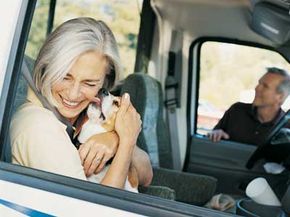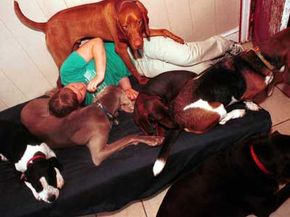 “Lots of kisses before the pooch gets dropped off at the kennel. See more pet pictures.Andersen Ross/Getty Images
“Lots of kisses before the pooch gets dropped off at the kennel. See more pet pictures.Andersen Ross/Getty Images
Odds are, if you have a pet, the day will come when you’ll have to leave it behind for a beach trip, exotic vacation or visit with grandma. Whether you travel frequently for business or just hit the road once a year, you’ll want to make the perfect arrangements for the care of your pet. For some pet lovers, this can be a stressful part of travel planning.
All pets and pet owners vary. Some pets settle into the boarding routine readily and seem to enjoy the change of scene. Others pine away for their owners, refuse to eat and are generally miserable for the entire stay. Likewise, some owners don’t think twice about dropping their pets at boarding facilities, while others wring their hands in fretful worry.
Whether you have a sensitive pet or you’re a sensitive pet owner, the best way to ease the stress of boarding your pet is to find a situation that both you and your pet are comfortable with. And, make sure your pet is prepared for its time away from home. Something as simple as making sure your pet understands basic commands or having it spend time around other animals and people will go a long way toward preparing your pet for the boarding scenario. Just remember — 30,000,000 pets spend time at boarding facilities in the United States and Canada each year. So your pet is no a pioneer. If you choose carefully, you’ll select a boarding facility that works for you both.
Contents
- Different Types of Pet Boarding Facilities
- How Pets Adjust to Boarding
- Health Concerns When Boarding Your Pet
- How to Choose the Right Boarding Facility
Different Types of Pet Boarding Facilities
 “A dog at a pet hotel located at Narita International Airport in JapanKoichi Kamoshida/Getty Images
“A dog at a pet hotel located at Narita International Airport in JapanKoichi Kamoshida/Getty Images
If you haven’t been to a pet boarding facility in a while, you might be surprised at today’s accommodations. While some facilities still favor the long rows of kennels — where, for an extra fee, your pet may also have access to a small outdoor run — improvements definitely have been made in the business of pet boarding.
If your pet is crate trained, then staying in a crate or kennel will probably make your furry friend feel more secure while away from home. But for pets that aren’t crate trained, staying in a crate or kennel can feel like jail. Many boarding kennels realize this and have changed how they keep animals.
Some boarding facilities keep the pets in large rooms together, where the animals can interact with each other and socialize. While this may be a good choice for many pets, it comes with its risks. It’s important that the person managing the kennel has experience dealing with animals that have a variety of personalities. Many cats, particularly those that are altered, will share a room with another foreign cat as long as the room is large enough and there are plenty of litter boxes. Dogs, however, present a challenge. Someone with experience can sort dogs according to size and temperament rather easily. A less experienced handler may recognize aggression and separate the dogs that have this trait. That leaves the nervous or overly submissive dog in a pack with more aggressive dogs. While no fights may result, the less dominate dog will be needlessly stressed during its stay at the kennel.
Before you decide to leave your pet at a facility that allows the animals to stay in communal rooms, visit the facility to see if the animals seem relaxed and happy. Look for any animal that seems stressed. Signs of stress in dogs include shaking, scratching, refusing to eat, avoiding eye contact and biting or growling. Signs that a cat is stressed include spraying, pacing, pulling at fur and excessive meowing.
Another way to board your pet is to leave it with your veterinarian. Many veterinarians provide this service for clients. Pet boarding is normally a secondary business for veterinarians, so vet offices may not have the most up-to-date facilities. Your pet may be in a crate all day, only taken out for several short walks by the staff. Of course this is not the case with all veterinarian facilities — it often depends on how much of the hospital’s business is made up of boarding clients.
Boarding at your veterinarian’s facility can be an excellent choice if your pet has a health condition or is elderly. Although a quality pet boarding facility will be equipped to deal with emergencies, for the pet with preexisting conditions, being at the vet is a definite benefit.
Pros and Cons of Pet Sitters
Many pet owners choose to hire a pet sitter. A pet sitter visits your home while you’re away and exercises, feeds and cleans up after your pet. A pet sitter may even perform other tasks — like collect your mail or water houseplants. Some people prefer pet sitters because it allows the animal to stay in its usual environment. Others prefer boarding because the pet is supervised the entire day, not just for two or three 30-minute sessions each day. There’s no right or wrong decision — it’s whatever works best for you and your pet.
How Pets Adjust to Boarding
 “A greyhound takes a snooze in a bed at a pet boarding facility.Darren McCollester/Getty Images
“A greyhound takes a snooze in a bed at a pet boarding facility.Darren McCollester/Getty Images
How your pet adjusts to boarding will depend on several factors. Many dogs are very content at a boarding facility, while others lose their appetites and long for home. Cats are both better and worse clients. They generally hate change and travel, so they may be unhappy at a boarding facility. But they rarely get so upset that they refuse to eat or drink.
You may like to assume that your pet’s discomfort at a boarding facility is due to its unbearable longing for you. But there are plenty of other reasons a pet doesn’t enjoy the kennel. A dog that’s used to plenty of outdoor exercise may be fine for a day or two at a kennel, but any longer and it will want more exercise than it can get in a small run. A dog that’s used to enjoying table scraps with dinner every night may refuse to eat, not because it’s stressed, but because it’s protesting the bland diet.
So how can you ensure your pet has the best time possible during its boarding facility stay? In the time leading up to your departure, note the amount of exercise your pet gets on an average day. Compare that to the amount of time the boarding facility will exercise it. If it appears that your pet will be more sedentary at the boarding facility, ask about paying for a few extra walks or runs.
Before you drop off Fido at the boarding facility, make sure he’ll eat his food without any additions. If you like to feed Fido treats, feed him pet treats, not table scraps. Then send a package of those treats with him to the boarding facility.
If your pet has a favorite toy or bed, send it along to the boarding facility, unless the facility doesn’t separate the animals. If the animals are kept together in an open area, you pet’s toy or bed may cause problems. Your pet, like a small child, may not want to share, and the other pets, like children, may try to force him to share. In an open boarding situation everything is community property. You can still send along special treats, but understand that the other animals will probably get some as well.
How anxious is too anxious?
If your dog or cat is anxious about being alone, it can be hard to tell whether it’s experiencing normal separation anxiety or something more serious. So how do you tell the difference? Dogs that ignore commands, become excessively lethargic or overly hyperactive, or resort to biting or growling are suffering from extreme anxiety. Cats that refuse to eat, pace, meow constantly or try to hide in their enclosure are experiencing extreme anxiety. Exercise is the best medicine for anxiety. So, you may consider requesting a few extra walks for your pet while it’s boarded. A last resort is prescription anti-anxiety medication, such as clomipeamine. Discuss this option with your veterinarian.
Health Concerns When Boarding Your Pet
 “A worker at a pet boarding facility pals around with the dogs.Darren McCollester/Getty Images
“A worker at a pet boarding facility pals around with the dogs.Darren McCollester/Getty Images
Any time your pet will be exposed to other animals, you should be concerned about health issues. Before boarding your pet, make sure it’s up-to-date on all vaccinations, as recommended by your veterinarian. Your furry friend should also be on a heartworm preventative and something to control fleas and ticks. Although most boarding facilities will require proof of vaccinations, parasite controls aren’t normally checked. If your pet isn’t up-to-date on this, it may bring home fleas, ticks or other health problems.
If your pet is due to receive inoculations before he is boarded, schedule the shots several weeks before your trip. This gives your pet time to build an immunity to the diseases — you don’t want to board it while its immunity is somewhat weakened. To ensure that your dog is protected while it’s away from home, immunize it against rabies, distemper, hepatitis, leptospirosis, parainfluenza, parvovirus and bordetella (kennel cough). Cats should be immunized against rabies, distemper, feline rhinotracheitis, calci virus and pneumonitis.
It’s just as important to your pet that the other pets at the boarding facility are immunized as well. Ask if proof of vaccinations is required when an animal is dropped off and which vaccinations are required. Immunizations are not 100 percent effective, and the best way to ensure that your pet stays healthy is to make sure all of the other animals around are healthy as well.
Kennel cough, or Bordetella, is a concern for pets that are boarded. Kennel cough is an infection of the upper respiratory tract that is very contagious. Symptoms of kennel cough can range from mild to severe. A mild case of kennel cough results in a dry hacking cough and a watery discharge from the nose. In a more severe case, a dog will be lethargic, refuse meals, develop a fever and may even develop pneumonia. Young and elderly dogs, as well as those with compromised immune systems, have even died from kennel cough.
Signs of kennel cough usually appear between two to 14 days after the dog is exposed, and the illness typically lasts around 10 days. One of the reasons this disease spreads so rapidly is that the dog can shed bacteria and spread the disease for six to 14 weeks after he quits showing symptoms of the illness. Mild cases of kennel cough are typically treated with bronchodilators or cough suppressants. More severe cases require antibiotics.
How to Choose the Right Boarding Facility
 “These dogs are having a ball at a pet boarding facility’s "playground."Darren McCollester/Getty Images
“These dogs are having a ball at a pet boarding facility’s "playground."Darren McCollester/Getty Images
It’s important to ask the right questions when you’re checking out a place to board your pet, but it’s even more important to visit the facility in person.
You can narrow down your boarding kennel selection over the phone by asking a few questions — for example: Is your facility a member of the of the American Boarding Kennel Association (ABKA)? The ABKA is a trade association that works to promote professional standards in boarding facilities. Members of the ABKA must agree to a code of ethics and may participate in voluntary inspections of their kennels.
You should also ask how the kennel deals with animals that become sick while the owner is away and how it deals with an animal that seems unusually stressed or anxious. If your pet requires special food or medications, ask if the kennel can accommodate your needs. If you have more than one pet you’ll be boarding and you’d like them to be housed together, ask if the kennel allows that. You might also save money doing this.
Make sure you understand how you’ll be billed and what time you should drop off and pick up your pet to ensure you’re not billed for additional days. If the dogs are kept inside and taken outside for exercise, ask how much exercise they’ll get each day. Also ask what accommodations are made for exercise when the weather is bad. By posing these questions, you should get a general idea how each kennel works and which ones seem reasonable.
Once you’ve narrowed down your choices of boarding facilities, visit each one and look around. A reputable boarding facility will have no issue with you visiting before making reservations for your pet. Look for clean facilities with plenty of light and adequate ventilation. The temperature should be comfortable. The staff should be interested in the animals, call them by name and act affectionate and caring. The cats should have ample room to move between food areas and litter boxes. Concrete is easy for facilities to keep clean. But animals should be able to lie somewhere soft as well.
Lastly, there’s one more step to take before making reservations. Call your state’s Better Business Bureau and ask if the kennel you’re considering has any complaints. If that report comes back clean, make reservations with confidence.
How much does all of this cost?
So, once you’ve found the perfect kennel for your pet, how much should you expect to pay? Prices vary widely across the country. When comparing costs, make sure you understand what’s included in the price. Some pricier kennels may include two walks a day and free time to run in a large yard. Meanwhile, another kennel may charge an extra fee for the same treatment. Make sure you’re comparing apples to apples when you’re choosing a kennel.
Lots More Information
More HowStuffWorks Articles
- How Pet Microchipping Works
- 6 Pets that Traveled Long Distances to Get Home
- Top 5 Risks When Driving with a Pet
- How Pet Shipping Works
- Do pets suffer jet lag?
More Great Links
- Signs of Stress in Cats
- Signs of Stress in Your Dog
Sources
- American Boarding Kennels Association. http://www.abka.com
- Eldredge, Debra M. et al. "Dog Owner’s Home Veterinary Handbook." 2007.
- The Humane Society of the United States. http://www.hsus.org/
- Overall, Karen L. "Treating Anxiety is Different than Managing Problem." DVM Newsmagazine. Jan. 1, 2003. (Jan. 8, 2008) http://veterinarynews.dvm360.com/dvm/article/articleDetail.jsp?id=43492

































